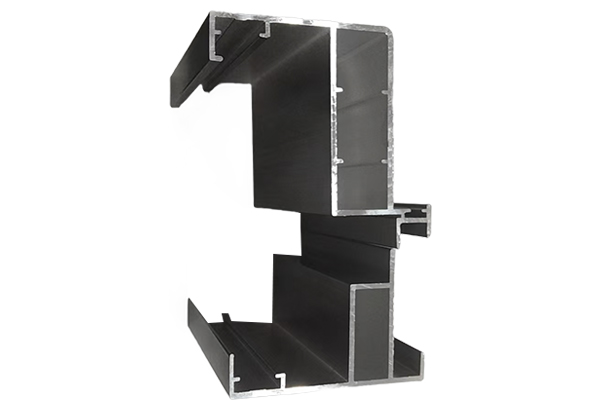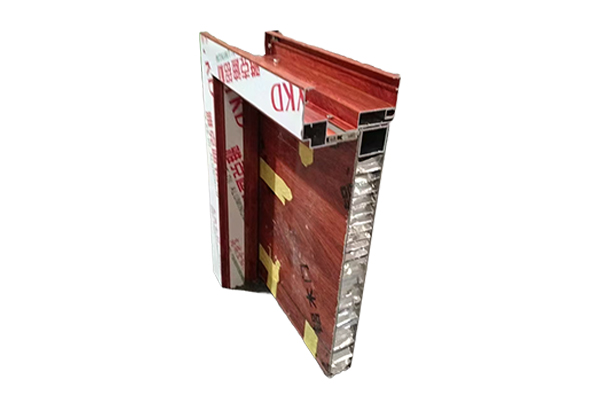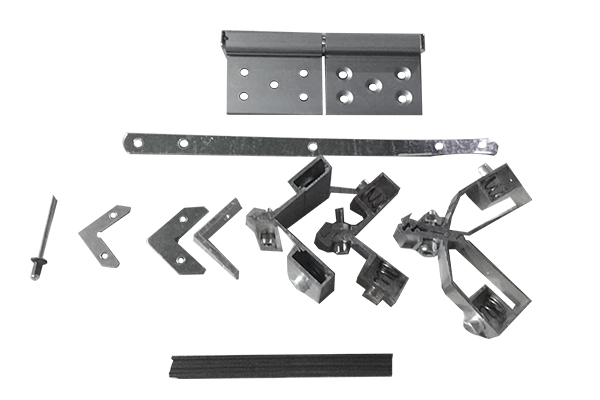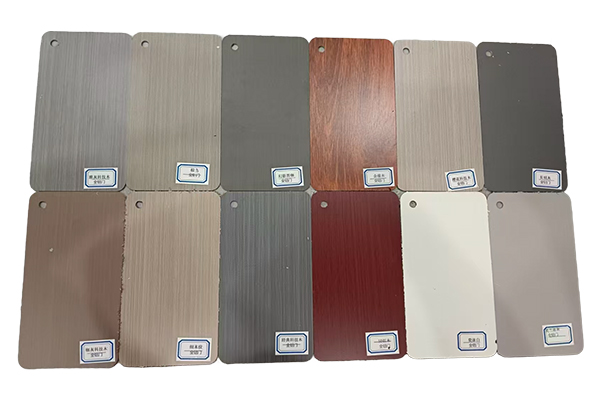How does the Honeycomb door panel perform in terms of fire resistance?
Release Time : 2025-08-04
The Honeycomb door panel boasts impressive fire resistance. It inherits many of the advantages of aluminum and further enhances its fire resistance through a unique honeycomb structure. This door panel plays a vital role in building fire safety, providing users with a safety solution that is both aesthetically pleasing and practical.
First, aluminum, as the primary material, gives the Honeycomb door panel excellent fire resistance. Aluminum's high melting point allows it to maintain structural stability in high-temperature environments and resists deformation or melting. In contrast, many traditional materials, such as wood and plastic, easily burn or soften when exposed to flames, rendering the door's protective function ineffective. Aluminum doors, on the other hand, maintain a certain level of strength and integrity even in a fire, effectively preventing the spread of flames and smoke, buying valuable time for evacuation and fire rescue efforts. Furthermore, the oxide film formed on the aluminum surface offers a certain degree of fire resistance, further enhancing its overall fire resistance.
Second, the honeycomb structure is a key factor in enhancing the door panel's fire resistance. The honeycomb-like internal structure not only reduces the door's weight but also significantly enhances its mechanical strength and stability. In high-temperature environments, the honeycomb core effectively absorbs heat and evenly distributes it across the entire door panel, preventing damage caused by localized overheating. This design enables the honeycomb door panel to maintain effective insulation even under high-temperature conditions, reducing the risk of heat transfer to the other side. Furthermore, the honeycomb structure prevents airflow, thereby slowing the spread of flames and providing a more durable protective barrier.
Furthermore, honeycomb door panels often undergo special fire-resistant treatments to further enhance their fire resistance. For example, during the manufacturing process, flame retardants may be added to the honeycomb core or the surface may be treated with a fire-resistant coating. These measures not only slow the spread of flames but also reduce the release of harmful gases, safeguarding indoor air quality. Fire-resistant honeycomb door panels, particularly in public spaces and high-rise buildings, meet stringent fire safety standards, ensuring the safety of people and property.
In addition to the aforementioned physical properties and processing, honeycomb door panels also feature design details that contribute significantly to their fire resistance. For example, the seal between the door frame and the door leaf is crucial. High-quality sealing strips fit snugly around door gaps, preventing smoke and flames from penetrating through them. Some high-end models feature double or multi-layer sealing structures for further airtightness. Furthermore, hardware components such as locks and hinges must also possess excellent fire resistance to ensure continued functionality in the event of a fire. These detailed design details collectively enhance the fire safety of the entire door system.
Notably, the adaptability of honeycomb door panels to diverse climates indirectly impacts their fire resistance. Made of high-quality aluminum and advanced manufacturing processes, honeycomb door panels offer strong corrosion resistance and weather resistance, enabling them to operate reliably in environments with both humidity and dryness, as well as extreme temperature fluctuations. This environmental adaptability means that the door panels are less susceptible to degradation or damage from external factors, maintaining optimal fire protection. Therefore, honeycomb door panels provide reliable fire protection for buildings, whether in the cold north or the scorching south.
Another highlight of honeycomb door panels is their versatility. Besides residential applications, these door panels are also widely used in commercial buildings, industrial plants, and public facilities. For example, fire safety is particularly important in high-traffic locations such as hospitals, schools, and office buildings. Honeycomb door panels, with their superior fire resistance and aesthetically pleasing design, are an ideal choice for these settings. Furthermore, with growing awareness of fire safety, more new projects are incorporating honeycomb door panels as standard features, driving their market penetration.
Finally, the economic benefits of honeycomb door panels cannot be ignored. While the initial investment may be relatively high, their durability and low maintenance make them a cost-effective option in the long term. The long lifespan and stable performance of honeycomb door panels eliminate the need for frequent replacement or repairs, saving significant time and money. For businesses and property managers, this translates to lower operating costs and a higher return on investment. Furthermore, high-quality fire-resistant door panels help enhance the overall value of a property, attracting more tenants or buyers.
In summary, honeycomb door panels demonstrate exceptional fire resistance. They leverage not only the inherent advantages of aluminum but also comprehensive protection through their honeycomb structure and special fire-resistant treatment. Whether facing high-temperature flames or complex environmental conditions, the Honeycomb door panel maintains stable performance, providing reliable safety for buildings. With the continuous advancement of technology and growing market demand, we believe that the Honeycomb door panel will demonstrate its unique charm in even more areas in the future, helping to build a safer and more harmonious living environment.
First, aluminum, as the primary material, gives the Honeycomb door panel excellent fire resistance. Aluminum's high melting point allows it to maintain structural stability in high-temperature environments and resists deformation or melting. In contrast, many traditional materials, such as wood and plastic, easily burn or soften when exposed to flames, rendering the door's protective function ineffective. Aluminum doors, on the other hand, maintain a certain level of strength and integrity even in a fire, effectively preventing the spread of flames and smoke, buying valuable time for evacuation and fire rescue efforts. Furthermore, the oxide film formed on the aluminum surface offers a certain degree of fire resistance, further enhancing its overall fire resistance.
Second, the honeycomb structure is a key factor in enhancing the door panel's fire resistance. The honeycomb-like internal structure not only reduces the door's weight but also significantly enhances its mechanical strength and stability. In high-temperature environments, the honeycomb core effectively absorbs heat and evenly distributes it across the entire door panel, preventing damage caused by localized overheating. This design enables the honeycomb door panel to maintain effective insulation even under high-temperature conditions, reducing the risk of heat transfer to the other side. Furthermore, the honeycomb structure prevents airflow, thereby slowing the spread of flames and providing a more durable protective barrier.
Furthermore, honeycomb door panels often undergo special fire-resistant treatments to further enhance their fire resistance. For example, during the manufacturing process, flame retardants may be added to the honeycomb core or the surface may be treated with a fire-resistant coating. These measures not only slow the spread of flames but also reduce the release of harmful gases, safeguarding indoor air quality. Fire-resistant honeycomb door panels, particularly in public spaces and high-rise buildings, meet stringent fire safety standards, ensuring the safety of people and property.
In addition to the aforementioned physical properties and processing, honeycomb door panels also feature design details that contribute significantly to their fire resistance. For example, the seal between the door frame and the door leaf is crucial. High-quality sealing strips fit snugly around door gaps, preventing smoke and flames from penetrating through them. Some high-end models feature double or multi-layer sealing structures for further airtightness. Furthermore, hardware components such as locks and hinges must also possess excellent fire resistance to ensure continued functionality in the event of a fire. These detailed design details collectively enhance the fire safety of the entire door system.
Notably, the adaptability of honeycomb door panels to diverse climates indirectly impacts their fire resistance. Made of high-quality aluminum and advanced manufacturing processes, honeycomb door panels offer strong corrosion resistance and weather resistance, enabling them to operate reliably in environments with both humidity and dryness, as well as extreme temperature fluctuations. This environmental adaptability means that the door panels are less susceptible to degradation or damage from external factors, maintaining optimal fire protection. Therefore, honeycomb door panels provide reliable fire protection for buildings, whether in the cold north or the scorching south.
Another highlight of honeycomb door panels is their versatility. Besides residential applications, these door panels are also widely used in commercial buildings, industrial plants, and public facilities. For example, fire safety is particularly important in high-traffic locations such as hospitals, schools, and office buildings. Honeycomb door panels, with their superior fire resistance and aesthetically pleasing design, are an ideal choice for these settings. Furthermore, with growing awareness of fire safety, more new projects are incorporating honeycomb door panels as standard features, driving their market penetration.
Finally, the economic benefits of honeycomb door panels cannot be ignored. While the initial investment may be relatively high, their durability and low maintenance make them a cost-effective option in the long term. The long lifespan and stable performance of honeycomb door panels eliminate the need for frequent replacement or repairs, saving significant time and money. For businesses and property managers, this translates to lower operating costs and a higher return on investment. Furthermore, high-quality fire-resistant door panels help enhance the overall value of a property, attracting more tenants or buyers.
In summary, honeycomb door panels demonstrate exceptional fire resistance. They leverage not only the inherent advantages of aluminum but also comprehensive protection through their honeycomb structure and special fire-resistant treatment. Whether facing high-temperature flames or complex environmental conditions, the Honeycomb door panel maintains stable performance, providing reliable safety for buildings. With the continuous advancement of technology and growing market demand, we believe that the Honeycomb door panel will demonstrate its unique charm in even more areas in the future, helping to build a safer and more harmonious living environment.







